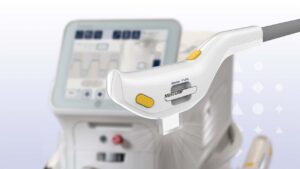PARAMETERS FOR PREDICTING EFFICACY WITH NONABLATIVE MONOPOLAR TREATMENTS
Background: Patient selection is key to obtaining a successful outcome after nonablative monopolar radiofrequency (NMRF)treatments to the forehead, face, and neck.
Objective: The purpose of this study was to discover at baseline from patient demographics, skin and fat characteristics, measurabledegrees of tissue mobility and photoaging, any predictors of a positive result under a standardized treatment algorithm.
Methods: Twenty-five patients (22 females, 3 males; average age 52.3 years) were selected randomly for NMRF treatments (2nonoverlapping passes, additional passes for vectored contraction and contouring) between 350 and 450 firings with 1.5-cmtips to the forehead, periorbitum, face, and upper neck. Patients were evaluated at baseline and monitored for outcomesbeyond 1 year by a number of quantitative assessments.
Results: At baseline and 3, 6, and l2 months, measurements of skin thickness, subcutaneous fat depth, tissue mobility, andwrinkle and fold depth were obtained at 9 different reference sites on each patient. Nineteen patients (76%) who progressivelyresponded to NMRF energy over 12 months were observed at baseline to have a global mobility score (mean ± SD) of3.4 ± 0.27 mm; 6 patients who were assessed to be nonresponders over l year of evaluation began with more tissue laxity andexhibited at baseline a larger global mobility score (mean ± SD) of 4.4 ± 0.60 mm. Other factors that were more likely to beassociated with a positive response to NMRF treatment included minimal degrees of photoaging and shallower wrinkle/folddevelopment. The variables of skin thickness and fat depth did not play significant roles in predicting positive responses totreatment. Side effects and complications were minimal throughout the study.
Conclusions: This study represents one of the first investigations that attempts to identify systematically objective baselineparameters that are more likely to be associated with positive responses to NMRF treatments to the forehead, face, and neck.Longer follow-up of our patients and further studies will be required to verify our preliminary findings.
Другие Статьи







